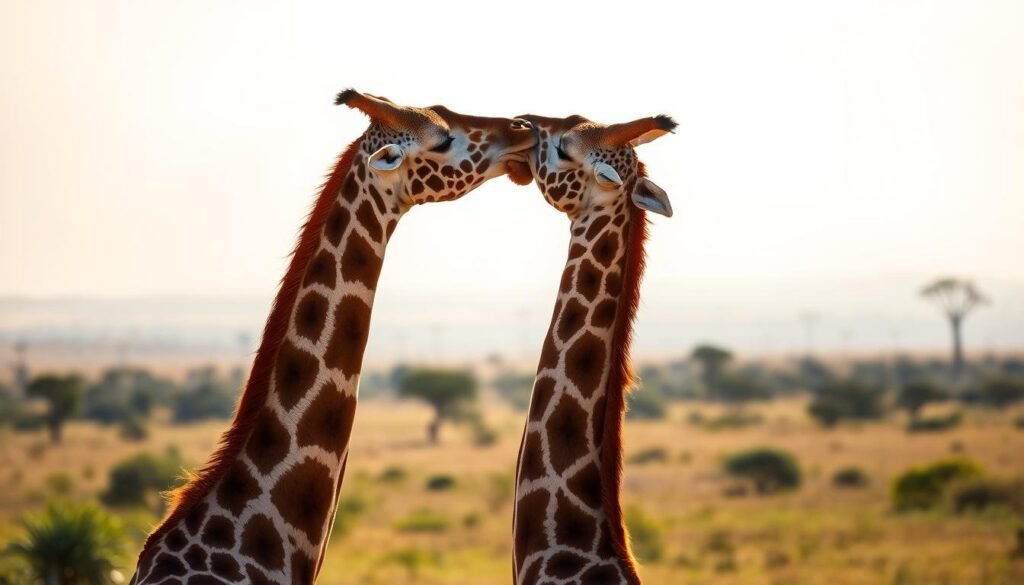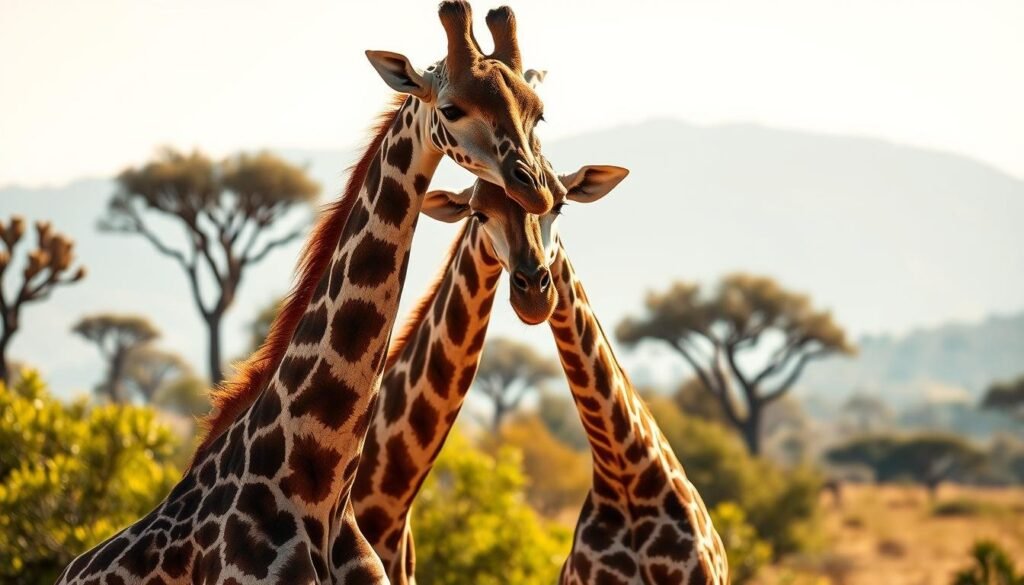Why Do Giraffes Rub Necks When Greeting? Giraffes have a special way of saying hello by rubbing their necks together. This act is key to their communication and building friendships.
This interesting giraffe behavior has caught many eyes. It shows us how complex their social lives are. Knowing how they communicate helps us understand their social groups and actions.
Looking into this unique greeting helps us see how giraffes connect with each other. It shows us the depth of their social bonds.
Contents
- 1 The Fascinating World of Giraffe Communication
- 2 Why Do Giraffes Rub Necks When Greeting?
- 3 The Social Significance of Neck-Rubbing
- 4 Evolutionary Purpose Behind Neck-Rubbing
- 5 Other Notable Giraffe Social Behaviors
- 6 Observing Giraffe Greeting Behaviors
- 7 Giraffe Neck Rubbing: A Unique Form of Communication
- 8 FAQ: Why Do Giraffes Rub Necks When Greeting?
- 8.1 What is the significance of neck rubbing in giraffe communication?
- 8.2 How do giraffes use body language to communicate?
- 8.3 What role does neck rubbing play in establishing social hierarchies among giraffes?
- 8.4 How has the evolutionary purpose behind neck rubbing been shaped?
- 8.5 What other notable social behaviors do giraffes exhibit?
- 8.6 What insights have been gained from observational studies of giraffe greeting behaviors?
- 8.7 How do giraffes interact with each other during greetings?
The Fascinating World of Giraffe Communication
Giraffe communication is truly fascinating. It involves many behaviors. They use vocalizations, body language, and physical interactions to talk to each other.
Vocalizations in giraffes are not as common as in other animals. But, they do make sounds like snorts, grunts, and bleats. These sounds help alert others to threats or show distress.
Body language is key in giraffe communication. They use postures and facial expressions to send messages. For instance, standing tall can mean dominance or relaxation.
| Form of Communication | Description | Example |
|---|---|---|
| Vocalizations | Sounds made to convey messages | Snorts, grunts, bleats |
| Body Language | Postures and facial expressions | Standing tall, relaxed posture |
| Physical Interactions | Direct contact between giraffes | Neck rubbing, head butting |
Physical interactions, like neck rubbing, are important in giraffe social behavior. These actions help strengthen bonds and establish social hierarchies.
Understanding these communication forms gives us insight into giraffe social structures. By studying their behaviors, we can appreciate the complexity of their interactions.
Why Do Giraffes Rub Necks When Greeting?
Neck rubbing is a special way giraffes greet each other. It’s not just a sign of love; it’s a key part of their social life. This behavior helps them connect and feel close.
Exploring the Emotional and Social Aspects
Giraffes rub necks to strengthen their friendships. This act helps keep the group calm and happy. It’s important for their well-being.
Neck rubbing also helps set up a pecking order. Giraffes show their place in the group by rubbing necks. This way, they know who’s who.
- Strengthening social bonds through physical contact
- Reducing stress and promoting a sense of calm
- Reinforcing social hierarchies and status
The emotional side of neck rubbing is deep. It shows affection and trust between giraffes. It helps us understand their emotional lives better.
To sum up, neck rubbing is a complex behavior. It’s about emotional connection, stress relief, and social order. It’s a key part of giraffe greetings.
The Social Significance of Neck-Rubbing
When giraffes rub necks, they strengthen their social bonds and show their hierarchy. This greeting is more than a simple gesture. It’s a complex social interaction that shapes their group structure.
Neck-rubbing helps giraffes establish and keep their social order. It lets them reaffirm their relationships and show their place in the group. This is key in a society where who’s in charge affects everything, like food and mates.
Neck-rubbing also helps reduce tension and bring the group closer together. It’s a gentle way for giraffes to ease conflicts and strengthen their bonds. This makes their group more stable and peaceful.
In summary, neck-rubbing is crucial for giraffes’ social lives. It helps set up their hierarchy, builds stronger bonds, and keeps the group united. Learning about this behavior gives us a deeper look into giraffe social dynamics.
Evolutionary Purpose Behind Neck-Rubbing
To understand giraffes’ neck-rubbing, we must look at their social life and how they communicate. This act is thought to help giraffes bond with each other. It’s a way for them to strengthen their social ties.
Giraffes live in a society with a clear hierarchy. Neck-rubbing might be their way of saying hello or making peace. It’s like how other animals groom each other to show friendship or settle disputes.
Giraffes face many challenges like predators and fighting for food. Neck-rubbing could be a key part of their social life. It helps them work together and survive in tough times.
In short, giraffes’ neck-rubbing is crucial for their social life. It helps them bond and solve problems. More studies on this behavior could reveal a lot about giraffe societies.
Other Notable Giraffe Social Behaviors
Giraffes have many social behaviors, like grooming and fighting. These actions help shape their social bonds and groups.
Giraffes show affection by grooming each other. They rub or nuzzle to strengthen their bonds. It’s not just for cleanliness but also to show love and ease tensions.
Young giraffes love to play. They run, buck, and play with their necks. This play helps them grow and learn social skills.
Adult giraffes also fight and spar. These fights help them figure out who’s in charge. They also solve problems in their group.
Studying these behaviors helps us understand giraffes better. It shows how they communicate and interact. This knowledge is key to understanding their social lives.
Observing Giraffe Greeting Behaviors
Scientists have learned a lot about giraffes by watching them in the wild. They’ve found out a lot about how giraffes say hello to each other. This has helped us understand their social lives better.
Giraffes have a special way of greeting each other. They rub their necks together. This shows they care for each other and helps them stay close in their groups.

How giraffes greet each other changes based on their mood. They rub necks more when they’re calm. But when they’re stressed or competing, they don’t do it as much.
Learning about animal greeting behaviors like giraffes helps us see their social lives. It shows us how they communicate and feel about each other. This knowledge is important for understanding giraffes better.
The study of giraffe behavior is very interesting. It shows us the complex social lives of these amazing animals. It’s something that scientists and animal lovers find fascinating.
Giraffe Neck Rubbing: A Unique Form of Communication
Giraffes have a special way of greeting each other. They rub their necks together. This shows their social bonds and who’s in charge.
Neck rubbing is key in giraffe social life. It strengthens their bonds and helps them share feelings and plans.
Learning about giraffes rubbing necks helps us understand their social world. It shows how important talking and socializing are to them.
See Also: Why Do Pandas Have a Pseudo-Thumb for Grasping?
FAQ: Why Do Giraffes Rub Necks When Greeting?
What is the significance of neck rubbing in giraffe communication?
Neck rubbing is key in giraffe communication. It’s a way for them to greet and bond socially.
How do giraffes use body language to communicate?
Giraffes communicate through body language. They use postures and facial expressions to share information and feelings.
Neck rubbing helps giraffes bond and establish their social order. It strengthens their social structures.
How has the evolutionary purpose behind neck rubbing been shaped?
Neck rubbing’s purpose evolved due to giraffes’ survival needs. It may have started as a way to communicate, bond, or solve conflicts.
Giraffes show many social behaviors. They groom, play, and interact in ways that shape their social bonds and structures.
What insights have been gained from observational studies of giraffe greeting behaviors?
Studies have shown how giraffe greetings work. They highlight the importance of neck rubbing in their social bonding and communication.
How do giraffes interact with each other during greetings?
Giraffes greet by rubbing their necks. This act is a key part of their social bonding and communication.

Zyair Larson, based in Denver, Colorado, has over 12 years of experience studying animal behavior. He has worked with the World Wildlife Fund (WWF) and National Geographic, researching wildlife and sharing insights on animal habits globally.

